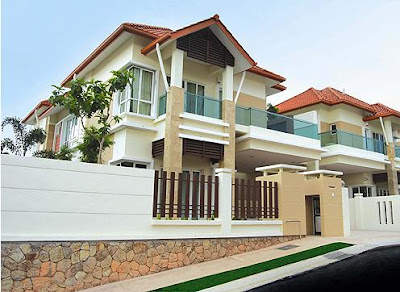 ELIGIBILITY
ELIGIBILITYAll Malaysian citizens are free to purchase houses within Malaysia save for low-cost houses which can be applied for through the relevant land offices or registries based on the relevant rules for eligibility. Houses built on Malay reserved land can only be purchased by Malays. Thirty percent of each housing project is to be reserved for Bumiputra purchasers who enjoy 5% to 8% discount on the purchase price. Foreign purchasers are subject to the approval of the Foreign Investment Committee (FIC) of the Economic Planning Unit of the Prime Minister's Department based on the FIC "Guidelines on the Acquisition of Properties in Malaysia by Foreign Interests".
2. TITLE
There are two categories of titles:
-freehold - which gives the owner perpetual ownership;
-leasehold - which allows the owner to stay in possession only for a specified period.
When the specified period ends, ownership reverts back to the authority which issued the title.
Generally, a house is issued a title for the piece of land on which the house is erected; and an apartment is issued a strata title for the specific area on the specific floor of the building in which the apartment or condominium is located. A search can be done at the relevant land offices or registries to determine whether the title is encumbered. If the title has not been issued, a search can be done on the master title on which the whole or part of the housing project is erected.
3. FINANCING
Banks and other financial institutions have different packages of housing loan to assist house buyers in their purchase. Pursuant to a recent Bank Negara guideline, house buyers can now only obtain housing loan of up to a maximum of 60% of the purchase price for the purchase of a second or subsequent house. Other than financing from a bank or financial institution, the Employees Provident Fund (EPF) currently provides two schemes of withdrawal for its depositors prior to attaining the age of 50:-
a. for purposes of buying or building a house or a shophouse consisting of a residential unit, depositors can withdraw the difference between the purchase price and the loan obtained plus 10% of the purchase price, or 30% of the total amount deposited in the EPF whichever is lower
b. for purposes of reducing or setting housing loans, depositors can withdraw 30% of the total amount deposited in the EPF, or the amount of the housing loan remaining outstanding, whichever is lower.
4. DOCUMENTATION AND PROCEDURES
All purchases direct from housing developers must use the Schedule G (for purchases of houses) or the Schedule H (for purchases of apartment respectively of the Housing Developers (Control and Licensing) Act 1996 as the sale and purchase agreements. Payment of the purchase price the said Schedules G and H is by progressive payment based on completion of work as certified by the architects. Payment of the last 5% of the purchase price will be held by a firm of solicitors as stakeholders for the defect liability period, which is currently 18 months from the delivery of vacant possession.
There are no fixed rules on the form of agreement for purchases from existing house owners (more commonly called sub-sale). However, it is common practice that upon signing of the sale and purchase agreement 10% of the purchase price be paid to the seller, and the purchaser be given 3 months to pay the balance of purchase price with an extension of 1 month if he fails to do so within the first 3 months' period. Interest at the rate of 10% per annum calculated on a daily basis is normally charged for the extension period. Payment of the balance of purchase price is usually made to the solicitors acting for the seller as stakeholders to ensure redemption of the house (if the same is still charged or assigned to a bank or financial institution at the time of sale) and payment of real property gains tax by the seller.
Other than the sale and purchase agreement, a memorandum of transfer, which is Form 14A of the National Land Code 1965, must be completed to transfer the title from the seller to the purchase. In instances where the title has not been issued, then if the purchase is from a developer, the developer will undertake in the sale and purchase agreement to transfer the title when the same is issued; and if the purchase is through a sub-sale, the transfer will be through an assignment of the sale and purchase agreement between the developer and the seller (Principal SPA) to enable the buyer to take benefit of the developer's undertaking to transfer the title contained in Principal SPA.
5. STAMP DUTY
Stamp duty is levied on the document of transfer (i.e. the memorandum of transfer if the title has been issued, or the deed of assignment of Principal SPA if the title has not been issued) based on the purchase price as follows:-a. 1% on the first RM100,000.00
b. 2% on the next RM400,000.00
c. 3% on the nest RM1,500,000.00 and
d. 4% on the remainder (item 32 [a] of the Stamp Act 1949)
6.LEGAL FEES
The first Schedule of the Solicitors Remuneration Order 1991 sets out the fees to be collected by lawyers for work done in handling the sale or purchase of house based on the purchase price as follows:-
1% on the first RM100,000.000.
5% on the next RM4,900,000.000.
25% on the remainder
For each sale and purchase of a house, the solicitors concerned can only collect fees based on the above scale from either the seller or the purchaser and not from both of them.
(Source : Lawyerment.com.my)
No comments:
Post a Comment